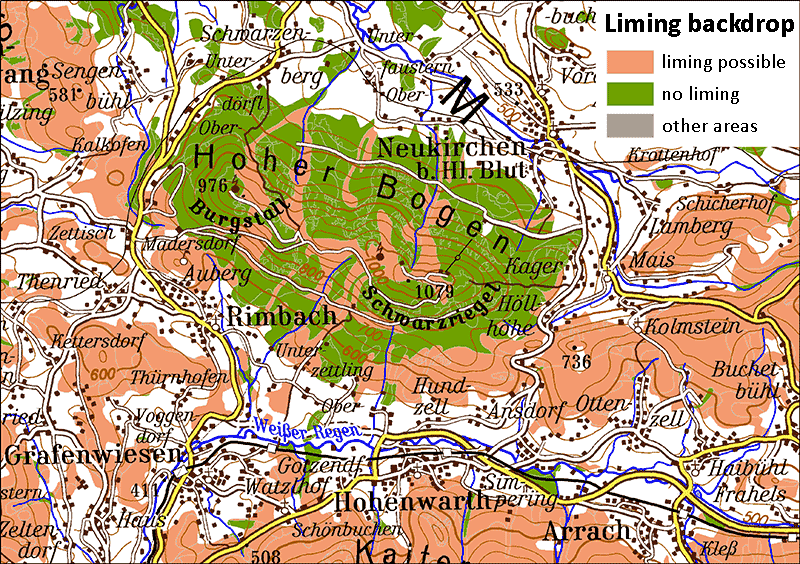Use, risk and side effects of forest liming
Liming can be understood as a form of therapy for sick soils and forests. As a result, clear reactions in the treated forests are intended and are most always achieved. If the liming is seen as a medical treatment, the question arises if the therapy is associated with more advantages than risks for the patient.
When liming the forest, it is important the check the necessity of the treatment and see if the advantages outweigh the disadvantages. This is because the measures:
- Produce costs,
- Display a significant carbon foot print,
- Can change ecosystems and compromise their self-regulation.
Lime in the forest is not simply a harmless household remedy that only presents advantages and usefulness.

Fig. 1: With a diagnosis from clear symptoms and/or a needle analysis there is no doubt about the necessity of a treatment. A dose of lime in such cases is extremely advisable (Picture: M. Hertel).
Motivation for the forest liming
The use of lime in the forest is primarily comprised of three goals:
- Neutralization of acids Neutral salts arise due to the neutralization of acids in rainwater that washed out of the soil as a result of percolation. The liming does not have an influence on the mobility of anions. These are, as always, held in the soil solution. Therefore, the loss of base cations in the subsoil can go on unconstrained after the soil is limed. With the decline of acid rain there has also been a strong reduction in the acidic input in the forests. As a result, the exposure of seepage water with sulfate and nitrate has been reduced. The aspect of neutralization with liming becomes less important when fewer air pollutants make their way into the forest.
- The regeneration of cation exchange sites occupied by acidic cations, such as aluminum, is increasingly being used as a motivation for liming. Aluminum, which is harmful to plants, is removed from the exchange sites through the addition of calcium and magnesium and thus provides a more favorable environment for the trees. However, it is unavoidable that products of reaction are released. Aluminum that has become displaced from the exchange site can pollute seepage water, become relocated in deeper soil horizons or streams and cause acidification. The acidification will be locally removed in the topsoil, but passed down with the seepage water.
- Influx of deficient nutrients If an acute deficiency of magnesium has been diagnosed, then a quick therapy of this nutritional disturbance is a dose of magnesium which can be taken in the form of dolomitic limestone. In Bavaria, liming the forest is mainly advisable when, due to the soil characteristics, a visible or latent nutrient deficiency in the long term is assumed or already diagnosed. The wellbeing of the stand is always in the foreground. The soil is only treated with lime so that the condition of the trees can improve.
The gentle path of humus care
An application of lime should always be viewed against the backdrop of the entire nutrient balance of the forest. Through tree species selection and the principles of admixture, the soil can be "browsed" to exhaustion by the roots of various trees in its entire depth. It is thus important, that the nutrients that are taken up from the subsoil are delivered to the topsoil through litterfall and harvest residues (i.e. slash). Forest trees have the capability to sustainably improve their own sites over centuries through their own "waste production". This should not be impaired, for example, through excessive harvests or other types of usage. It is decisive to care for and maintain the nutrient and water storage characteristics of the humus layer in our forests. Liming is only considered a supportive remedy when the nutrient balance of the forest is impaired to such an extent that the danger of malnutrition and deficiency could arise. The goal of near to nature forestry primarily remains the concept of self-regulation. This concept entails the incorporation of site appropriate and mixed tree species with a high proportion of broadleaves, the securement of the long-term capability of natural regeneration and the utilization of harvest operations that are gentle on the soil. Liming in Bavaria is only encouraged after consideration of the soil condition and nutrient situation on critical sites. This ensures that no negative effects on the ecosystem arise as a result of the application of lime.

Fig. 2: A liming backdrop for the forested area in Bavaria (LWF 2010/2013 excerpt): The green areas do not require liming. Liming could be considered useful on the red areas. Sites that can be excluded from liming include nutrient rich sites, proximity to water, wet and dry sites plus sites with exposed bedrock and boulders.
Endpoints
In human medicine the clinical endpoint is the condition that is to be reached through a medical treatment. As a result, measureable and clearly defined criteria are determined.
Which clinical endpoint is sought for by liming? Should the pH value after the treatment measure 4,5 or 5,65? Is a mull humus form desired or will a moder suffice? Should the soil have many or just a few earthworms? And what does "many" or "just a few" mean? Are stands with satisfactory levels of nutrition with out deficiencies enough or is there an ambition to maximize growth? Should the level of base saturation be fifteen percent or is ten percent acceptable? What is a "good" soil condition? The original condition from around 1000 AD with minimal anthropogenic influence, the highly altered historical condition after the overexploitation of the modern era around 1900, the once more modified condition through acid rain after 1980 or the presently varied condition after liming measure?
The protection against damage, disadvantages and influences from conducting soil protection measures is defined in federal soil protection laws in Germany. In a managed forest the main soil function is to serve as a site for utilization through agriculture and forestry. The core issue is to determine how the usage is influenced through destructive changes to the soil: Can the trees grow and thrive as expected from forest landowners and forestry officials under the given soil condition? Or do these people have to intervene in a regulatory manner? Questions about soil protection in the forest are: Should soil functions be ensured and restored beyond those that simply serve as "a site for production"? Should the waterways downstream also be taken into consideration? Is the soil as the basis of life and habitat for humans, animals, plants and soil organisms in danger?
It is time to make a consensus about the endpoints that are to be achieved and to build a consensus about the level of quality the forest soil should have and how this can be achieved. In natural systems like the forest every last endpoint doesn't have to be realized and every condition doesn't have to be optimized. Ultimately it is the diversity of rich and poor soils, of fast and slow growing forests and of wild and tamed nature that makes our forest environment so exciting. Liming the forest isn't a question of natural science, but rather a societal and political question.
